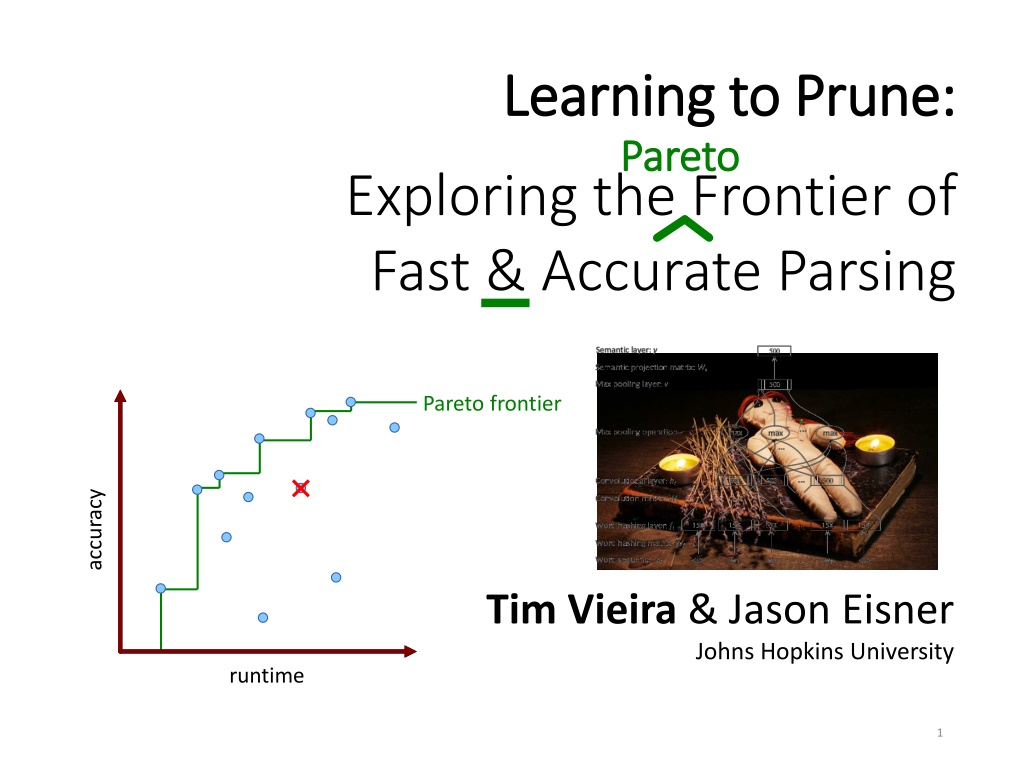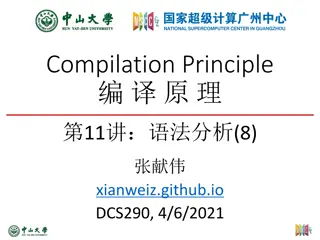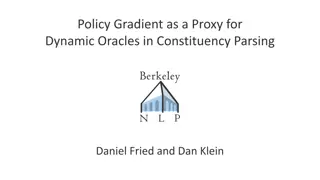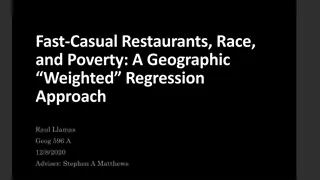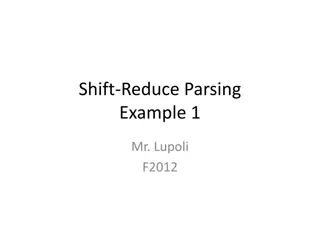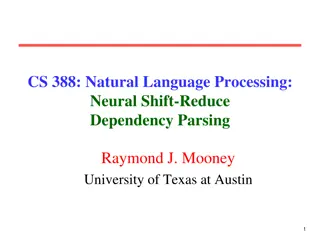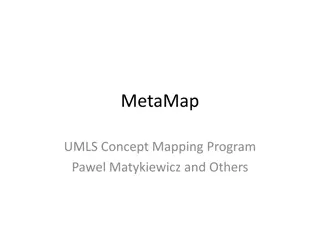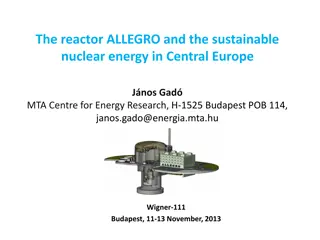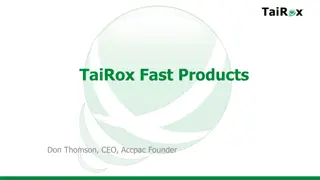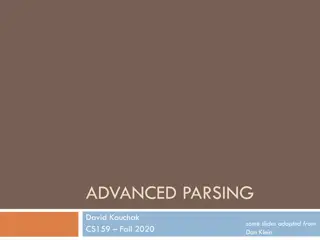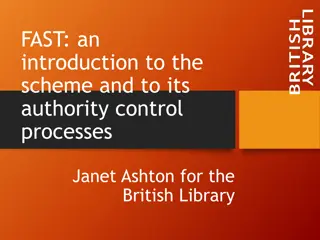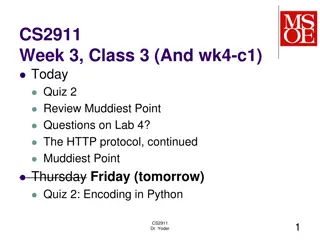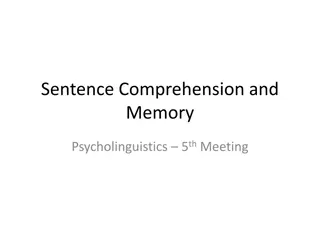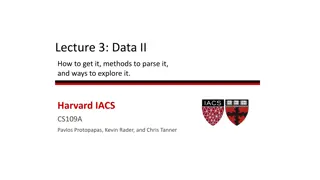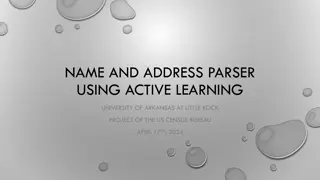Exploring Fast & Accurate Parsing With Learning to Prune
In this informative content, the concept of learning to prune is discussed in the context of exploring the frontier of fast and accurate parsing. It delves into the optimization tradeoff between runtime and accuracy in end-to-end systems, showcasing a Pareto frontier of different system performances. Through images and examples, the text illustrates how pruning techniques can save runtime by selectively avoiding operations on nonterminals. The content highlights the importance of tuning systems' runtimes using machine learning for both accuracy and speed. Additionally, it provides insights into parsing grammars and the significance of pruning for efficient parsing operations.
Download Presentation

Please find below an Image/Link to download the presentation.
The content on the website is provided AS IS for your information and personal use only. It may not be sold, licensed, or shared on other websites without obtaining consent from the author. Download presentation by click this link. If you encounter any issues during the download, it is possible that the publisher has removed the file from their server.
E N D
Presentation Transcript
Learning to Prune: Learning to Prune: Pareto Pareto Exploring the Frontier of Fast & Accurate Parsing Pareto frontier accuracy Tim Vieira & Jason Eisner Johns Hopkins University runtime 1
Learning to Prune: Learning to Prune: Pareto Pareto Exploring the Frontier of Fast & Accurate Parsing as fast Pareto frontier more accurate accuracy runtime 2
Learning to Prune: Learning to Prune: Need systems with tunable runtimes Pareto Pareto Exploring the Frontier of Fast & Accurate Parsing Pareto frontier accuracy We already use ML to learn be accurate. This work uses ML to learn to be fast too! runtime 3
Learning to be Fast & Accurate Tradeoff parameter - = rewar d accurac y runtim e Accuracy and runtime of the end-to-end system accuracy Optimizing for different 's gives a Pareto frontier of systems runtime 4
Parsing ROOT Grammar @S NP VP VP VBD NP NP DT NN DT the VBG cooks NN chef S VP PP VP NP NP NP VBD ate DT the IN DT a NN <.> . NN Papa caviar with spoon 5
Parsing ROOT ROOT0 Grammar @S0 NP0 VP0 @S0 NP0 VP1 @S0 NP0 VP2 @S0 NP1 VP0 Grammar @S NP VP VP VBD NP NP DT NN DT the VBG cooks NN chef VP0 VBD0 NP0 NP0 DT0 NN0 NN39 spoon VBD2 ate DT0 the S S0 VP VP0 Berkeley Grammar (sm6): up to 64 refinements to each non-terminal @S1 NP0 VP0 PP PP5 VP VP19 NP NP35 NP38 NP NP NP31 Papa VBD VBD2 ate DT DT0 the IN IN23 with DT DT15 a NN NN39 <.> <.>2 . NN NN8 caviar spoon 6
Parsing in a nutshell O(|G| width) runtime per span SLOW! VP VP PP Papa ate the caviar with a spoon . 8
Speeding up parsing What could we easily prune? Pruning saves runtime by avoiding the fill operation Prunes all nonterminals that might cover that span Roark & Hollingshead (2008) Bodenstab et al. (2011) Final "." attaches at the top "[ with ] a" is a bad place to end a constituent with a spoon . Pap a at e th e cavia r 9
Ideally Train a classifier to predict whether a span is GOLD or NON-GOLD ROOT S (Bodenstab et al., 2011) @S PP VP NP NP NP VBD DT IN DT NN <.> NN with a spoon . Pap a at e th e cavia r 10
Impact of PRUNE depends on context (sentence, grammar, other PRUNE choices) Gold spans are bad to prune, but not equally bad recovers by finding a pretty good parse fails with no parse :-( 11
Impact of PRUNE depends on context (sentence, grammar, other PRUNE choices) Gold spans are bad to prune, but not equally bad Non-gold spans are good to prune, but not equally good saves a lot of BUILD time for this span and other spans built as a result :-) saves a tiny bit of BUILD time also, kills off a top-scoring but wrong parse :-) 12
Impact of PRUNE depends on context Want our classifier to take this into account a few mild errors really bad error Bodenstab et al. (2011) just weight gold errors more than non-gold We refine this approach by considering the real cost of each error in context 13
End-to-end training What if we prune here instead? rollout = - accuracy runtime 15 15
Rolling out lots of changes to get training data prohibitively slow to train! "second-guess" each decision the current classifier makes Weighted classification dataset LOLS (Chang+,2015) Retrain the classifier 16 16
Change propagation Already computed this This is such a tiny change. Do you really want to re-run the parser from scratch? 18
Changeprop Changes quickly "peter out" because each span only cares about its best derivation. Immediate effects lie in this range Changes may cascade 90% of rollouts change < 10% of the chart Change this span Homework: figure out the rest. Hints: use indexing data structures a priority queue of changes to process and an undo list (to flip back quickly) 19
Dynamic programming speedup Rollouts are basically computing a gradient! change in reward change in input 20
Dynamic programming speedup Not differentiable! We use expected reward as a differentiable proxy Relax decoding to be stochastic 21
Dynamic programming speedup 10-14x faster! O(G n3) O(n2) O(G n3) = O(G n5) * Efficient for a certain class of reward functions with a variant of inside- outside (Li & Eisner,'09) 22
Experiments 23
Controlled experiment Setup Data: English Penn Treebank Reward: corpus-level F1 - number of edges built Grammar: Coarse: Vanilla PTB grammar Fine: Berkeley split-merge grammar level 6 Two training speed-ups changeprop (CP): per-sentence F1 - number of nodes built dynamic programming (DP): expected recall - size of mask 24
Learning curve Sweep baseline curve by varying asymmetric penalty 25
Learning curve Infer a value that the baseline seems to optimize 26
Learning curve Train with LOLS for 6 days On the 7th day, LOLS rested, and performance was good! 27
Test set results: Coarse-grained grammar millions of edges built per sentence = significantly higher reward (paired permutation test, p < 0.05) 30
Conclusions Learning systems that are fast and accurate (in the Pareto sense) is an exciting new area. We looked at pruned dynamic programming. We found that optimizing end-to-end performance lead to better frontier in the case of parsing. Not all errors are equal, so we must measure the consequences of each pruning decision. Measuring these consequences requires running the system over and over again with different pruning masks. We sped this up with our change propagation and dynamic programming algorithms. 32
Thanks! @xtimv github.com/timvieira/learning-to-prune 33
Backup slides 35
Relationship to other parsers Slightly faster & more accurate than the method that inspired our baseline 36
Changes are really sparse! % of chart changed 37 37
Empirical comparison (seconds) Runtime Average time to do all rollouts Sentence length 38
Runtime? #symbols in each cell of a realistic grammar O(G*n^3) O(n^2) cells O(G*n) time to fill each cell How many grammar lookups to fill this cell 255*484 + 443*484 + 456*483 + 472*471 + 488*347 = 949,728 Almost a million lookups for one cell! 39
Speeding-up rollouts CP coarse grammar: 4.9-6.6x faster fine grammar: 1.9-2.4x faster DP coarse grammar: 10.4-11.9x fine grammar: 10.5-13.8x 40
Runtime with Jacobian General trick: apply expansion before nonlinearity. Needs T Jacobian-vector products which is asymptotically as slow as running inference n^2 times This is because computing marginals happens has worse constant factors than one-best so It's better to use Changeprop is much faster. 41
Hard to optimize Cross-section of objective along a random direction high-dimensional riddled with local optima Hard to search directly in parameter space piecewise constant Instead, we optimize by iteratively refining the supervision given to the classifier 42
